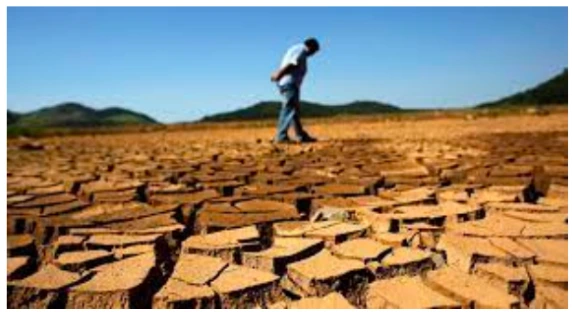Answer:
Approach:
- Introduction: Start by highlighting the link between climate change and its impact on public health, emphasizing the disproportionate effects on disadvantaged communities.
- Body:
- Discuss how limited resources and poor infrastructure amplify health risks due to climate change.
- Examine the increased frequency of disasters like floods and their health implications on these communities.
- Address how climate change-induced air pollution adversely affects health, especially in urban slums.
- Highlight the mental health aspect, focusing on the stress and anxiety caused by climate-related disasters.
- Analyze the influence of climate change on the spread of diseases in regions with limited healthcare.
- Discuss the impact of climate change on agriculture and water sources, leading to health crises.
- Conclude this section by pointing out the limited capacity of these communities to adapt to climate-induced health challenges.
- Conclusion: Summarize by stressing the need for comprehensive policies that integrate climate change mitigation with healthcare improvements for disadvantaged communities.
|
Introduction:
Climate change, a multifaceted global issue, poses a significant threat to public health, disproportionately affecting disadvantaged communities. The escalating severity of climate-induced disasters, such as heatwaves, floods, and storms, coupled with long-term changes like rising temperatures and altered precipitation patterns, exacerbates health challenges for these populations.
Body:
Vulnerability of Disadvantaged Communities:
- Disadvantaged communities, often characterized by limited resources, poor infrastructure, and inadequate access to healthcare, are particularly vulnerable to climate change.
- For example, in regions like Sub-Saharan Africa, recurrent droughts, attributed to climate change, have led to food insecurity, malnutrition, and increased susceptibility to diseases like malaria and cholera.
Impact of Extreme Weather Events:

- Climate change has increased the frequency and severity of extreme weather events, directly impacting the health of disadvantaged communities.
- For example, the 2022 Pakistan floods, exacerbated by climate change, disproportionately affected the poor, leading to outbreaks of waterborne diseases and straining the already limited healthcare resources.
Air Quality Deterioration:
- Increased air pollution, a byproduct of climate change, has severe health implications, especially for marginalized groups in urban areas.
- For example, in India, cities like Delhi face hazardous air quality levels, exacerbating respiratory conditions among the poor who lack access to quality healthcare and clean living environments.
Mental Health Concerns:
- The mental health impact of climate change, often overlooked, disproportionately affects disadvantaged groups who have fewer coping resources.
- For example, studies show increased rates of anxiety and depression among communities in areas frequently hit by climate-induced disasters.
Spread of Vector-Borne Diseases:
- Climate change alters the distribution of vectors like mosquitoes, increasing the spread of diseases such as dengue and Zika, primarily affecting poorer regions with inadequate health infrastructure.
- For example, the recent surge in dengue cases in Southeast Asia is partly attributed to changing climatic conditions favoring mosquito breeding.
Food and Water Security:
- Climate change impacts agricultural productivity, leading to food scarcity and water contamination, which hits disadvantaged communities hardest.
- For example, in the Horn of Africa, prolonged droughts have led to famine-like conditions, directly impacting the health of millions.
Lack of Adaptive Capacity:
- Disadvantaged communities often lack the adaptive capacity to respond to climate-related health challenges due to socio-economic constraints.
- For example, in small island developing states, limited resources hinder effective responses to climate change-induced health crises, like the spread of waterborne diseases after cyclones.
Conclusion:
The interplay between climate change and health is a pressing global concern, with disadvantaged communities bearing the brunt of this crisis. It underscores the need for inclusive, proactive policies that address both climate change mitigation and adaptation, with a focus on strengthening healthcare systems in vulnerable regions. The recent COP27 summit’s emphasis on climate justice and funding for loss and damage in developing countries is a step in the right direction. However, more concerted efforts are required at both global and local levels to safeguard the health of the most vulnerable against the backdrop of an evolving climate landscape.
To get PDF version, Please click on "Print PDF" button.


https://uploads.disquscdn.com/images/1af772398e8b1ad6c4350fb6657f9fb05b0f507a55ff468b4a8ffa664d99e48a.jpg https://uploads.disquscdn.com/images/67a1b8ec6c982a57bb155bc3a27335bca402e7c0fa4b9ba2dc9093de12f1272d.jpg
https://uploads.disquscdn.com/images/5a26b5103ff3b0d7a96a20cbb1b5d3ac58bb95d9c4fb0ee746a756ed199e71f7.jpg https://uploads.disquscdn.com/images/05687d7d014f7993e6d28d1645053228f7a1e112d74ca852a5dc80fb300732b0.jpg
https://uploads.disquscdn.com/images/5b4783c59df3963ac74d0ce6aedd1f798c517c60e03ca3aac847db6440e81128.jpg https://uploads.disquscdn.com/images/1feb7eaf1be980d520ba3dfb538f63e6fb4f23d9d845476d1b269c2c6f41ea5a.jpg https://uploads.disquscdn.com/images/4f6fa0344b08f8e55b5aab054f8a4c7a4a864e9037d9a6d0532387546cd4a01f.jpg
Nice
https://uploads.disquscdn.com/images/93f9850e8aca87d39ead297d6c8df59055405be4e5ee6afa935773508a5adeca.jpg https://uploads.disquscdn.com/images/f00b86eaf99be1a34163b91444e194df386e26ad73f8fc8018ef3b5426540b6b.jpg
https://uploads.disquscdn.com/images/6db551125dc874ba29a8bdb84428f2655ba7f56350e1e60656a68f960ef9d243.jpg
https://uploads.disquscdn.com/images/759601bb9f7d25eaa541864b76a0bbeef0890e0ea3300568aa82b14d57c236a6.jpg https://uploads.disquscdn.com/images/649729f2bb232b06e5843dc9888b08aea6bfa9d4eed3e6e1028c6ebb85d47dbd.jpg
https://uploads.disquscdn.com/images/ae3a18d6a7d04abe464578a107ef915feeea6edeb95c463fc73fe23bb02b5122.jpg https://uploads.disquscdn.com/images/774a928d36165189f5aacd8734408bc485120ef50e869fab1162b42abfb7b96c.jpg
https://uploads.disquscdn.com/images/33d44042ea5342e3b1f044e7bfee7754ef89cd0c69636d56eb3755149eb3a636.jpg https://uploads.disquscdn.com/images/d830988df73e8c4afedd731e7a341dd4039317acb1ce6bc78804778286bdd3e2.jpg
https://uploads.disquscdn.com/images/60aec1cc18c3193e401b0c534638cabcc19f6dbe419ed4966d7b248c035ada58.jpg https://uploads.disquscdn.com/images/8b039a624c73b18d67ca3591875089516bf32791051a92796dbe6e9b36a6578a.jpg
https://uploads.disquscdn.com/images/272f63827492f066fef6ddcd6fd114365f6636cdb0a4fb79dd3802cc03a1d0b8.jpg https://uploads.disquscdn.com/images/8d04ec38b46a152cc7452020837be8767635d966a97563575433d330f79c5616.jpg
https://uploads.disquscdn.com/images/6e71763c51c222c25b40e1429f80f50ae522c945670255239880744ce5a5f3a5.jpg https://uploads.disquscdn.com/images/2f89d2af1be50d8c4cffd1dbbff2b581e940db704721a6315174f4aa8b6c604a.jpg
https://uploads.disquscdn.com/images/9c6935ad54e71041ffb5b964b49edfd71773fdf7986d98f87e4cfc620659731f.jpg https://uploads.disquscdn.com/images/8102a4a6b74f605ac1e390da3d80f2c5147d758158467b49d54e1d57e602e25f.jpg
https://uploads.disquscdn.com/images/ad0efd67e49936402273e9486733beafd15aefa46961ad4da8819ef0f9e8ab00.jpg https://uploads.disquscdn.com/images/044089e0727d1cfc3ad4fc03164657c16ad3e2e04e4b73789fd9a1f204e2db60.jpg